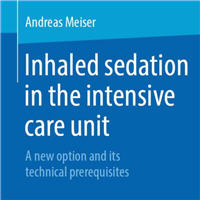Tag: sedation
Inhaled Sedation in the ICU: A New Option and Its Technical Prerequisites
Andreas Meiser summarizes the current literature on inhalation sedation of critically ill patients. To meet clinical demands, he describes the development of new devices to administer volatile anesthetics together with common... read more

Clinical Trials Design Evaluating Sedation in Critically Ill Adults Requiring Mechanical Ventilation
These recommendations are intended to assist researchers in the design, conduct, selection of endpoints, and reporting of clinical trials involving sedative medications and/or sedation protocols for adult ICU patients who... read more
Melatonin for Delirium Prevention in Hospitalized Patients
Melatonin/ramelteon are associated with reduction in delirium incidence in hospitalized patients. However, this effect seems confined to surgical and ICU patients. The optimum dosage and formulation of melatonin, and... read more
The Relationship of Delirium, Sedation, Dementia, and Acquired Weakness
The advent of modern critical care medicine has revolutionized care of the critically ill patient in the last 50 years. The Society of Critical Care Medicine (was formed in recognition of the challenges and need for specialized... read more
Higher Level of Mobilization Improves Health Status
In critically ill survivors, achieving higher levels of mobilization, but not increasing the number of active mobilization sessions, improved health status 6 months after ICU admission. The dosage of mobilization in ICU... read more
Percutaneous Ultrasound Guided Gastrostomy Tube Placement
Percutaneous ultrasound guided gastrostomy (PUG) is similar in terms of complications to percutaneous gastrostomy tube (PRG) placement and a safe method for gastrostomy tube placement in the critically ill with the added... read more
Checklist for Early Recognition and Treatment of Acute Illness and Injury
A quality-improvement intervention with remote simulation training to implement a decision support tool was associated with decreased nonadherence to daily care processes, shorter length of stay, and decreased mortality. The... read more
Sedation, Analgesia, and Paralysis in COVID-19 Patients in the Setting of Drug Shortages
The rapid spread of the severe acute respiratory syndrome coronavirus-2 (SARS-CoV-2) has led to a global pandemic. The 2019 coronavirus disease (COVID-19) presents with a spectrum of symptoms ranging from mild to critical... read more
Rapid Sequence Induction: Where Did the Consensus Go?
The conduct of Rapid Sequence Induction (RSI) in current emergency practice is far removed from the original descriptions of the procedure. Despite this, the principles – rapid delivery of a definitive airway and avoiding... read more
Sevoflurane in Murine Peritonitis-induced Sepsis
Sevoflurane exerts various protective effects in two murine peritonitis-induced sepsis models. These protective effects were linked with a functional adenosine A2B receptor. Sevoflurane reduced the neutrophil counts in... read more
Undercover Epicenter Nurse: How Fraud, Negligence, and Greed Led to Unnecessary Deaths at Elmhurst Hospital
What would you do if you discovered that the media and the government were lying to us all? And that hundreds, maybe thousands of people were dying because of it? Army combat veteran and registered nurse Erin Olszewski’s... read more

Bedside Voluntary and Evoked Forces Evaluation in ICU Patients
Around one third of intensive care unit (ICU) patients will develop severe neuromuscular alterations, known as intensive care unit-acquired weakness (ICUAW), during their stay. The diagnosis of ICUAW is difficult and often... read more
Sedation with Midazolam After Cardiac Surgery in Children with and without Down Syndrome
The majority of children with and without Down syndrome required additional sedation after cardiac surgery. This pharmacokinetic and pharmacodynamic analysis does not provide evidence for different dosing of midazolam in... read more
Replacement of Fentanyl Infusion by Enteral Methadone Decreases the Weaning Time From Mechanical Ventilation
The introduction of enteral methadone during weaning from sedation and analgesia in mechanically ventilated patients resulted in a decrease in the weaning time from mechanical ventilation (MV). A double-blind randomized... read more
A Bad Sedation Package Leaves your Patient Trapped in a Nightmare
Pushing some ativan followed by vecuronium is no longer an acceptable strategy to manage post-intubation sedation. A good analgesia and sedation package is essential if you care about your patient's comfort and well-being.... read more
Conversion From Continuous Infusion Fentanyl to Continuous Infusion Hydromorphone in the Pediatric ICU
A median 14% fentanyl dose reduction was noted when transitioning to hydromorphone. Further exploration is needed to determine if opioid rotations with hydromorphone can reduce opioid/sedative exposure. A total of 36 children... read more
Balanced Opioid-free Anesthesia with Dexmedetomidine vs. Balanced Anesthesia with Remifentanil for Noncardiac Surgery
This trial refuted the hypothesis that balanced opioid-free anesthesia with dexmedetomidine, compared with remifentanil, would result in fewer postoperative opioid-related adverse events. Conversely, it did result in a greater... read more
Early sedation with dexmedetomidine in ventilated critically ill patients and heterogeneity of treatment effect in the SPICE III randomised controlled trial
In critically ill mechanically ventilated patients, early sedation with dexmedetomidine exhibited a high probability of reduced 90-day mortality in older patients regardless of operative or non-operative cluster status. Conversely,... read more
The Effect of Early Sedation With Dexmedetomidine on Body Temperature in Critically Ill Patients
Previous case series reported an association between dexmedetomidine use and hyperthermia. Temperature data have not been systematically reported in previous randomized controlled trials evaluating dexmedetomidine. Our... read more
Analysis of Fentanyl Pharmacokinetics and Tolerance in Critically-Ill Children
Different weight-based fentanyl dosing rates may be required for infants and children of different ages to achieve similar plasma concentrations. Using SBS scores may guide the dosing titration of fentanyl that resulted in... read more
Delirium Incidence, Duration, and Severity in Critically Ill Patients with COVID-19
Delirium without coma occurred in 29.1% of patients admitted to the ICU. Delirium persisted for a median of 5 days and was severe. Mechanical ventilation was significantly associated with odds of delirium even after adjustment... read more
Perspectives of Ketamine Use in COVID-19 Patients
Hospitalized coronavirus disease 2019 (COVID-19)-infected patients suffer from both physical impairments and mental stress. Respiratory insufficiency and cardiovascular disturbances require most of the intensive care... read more









